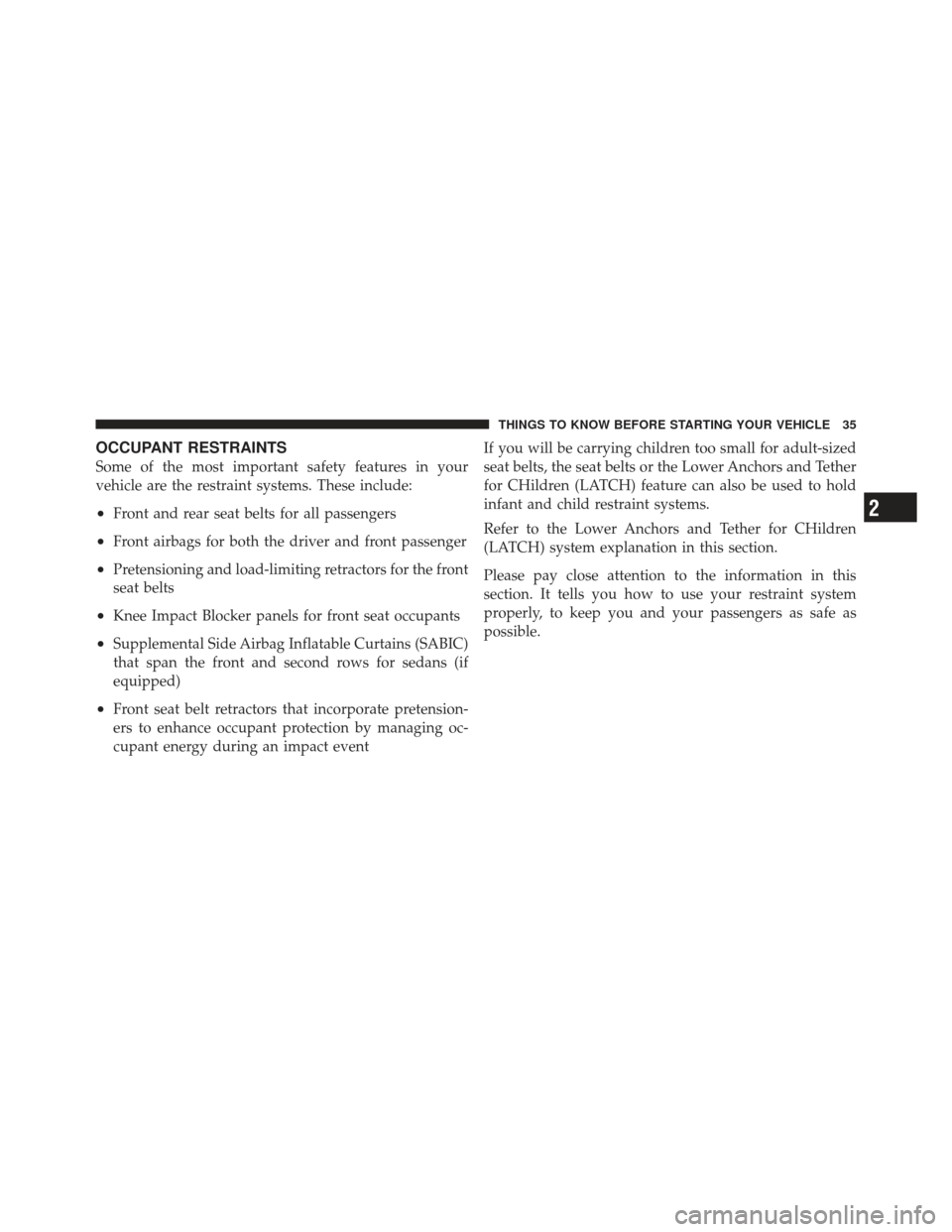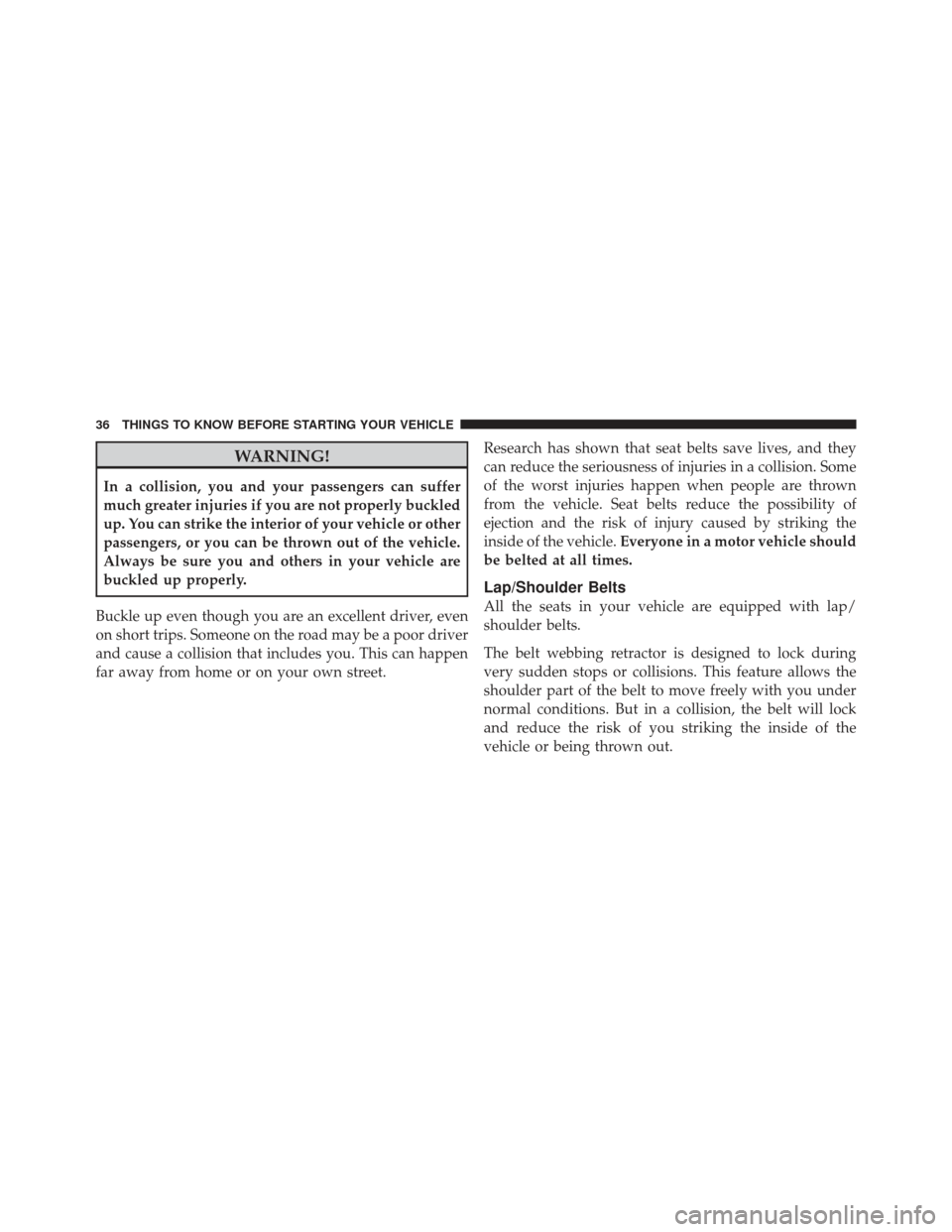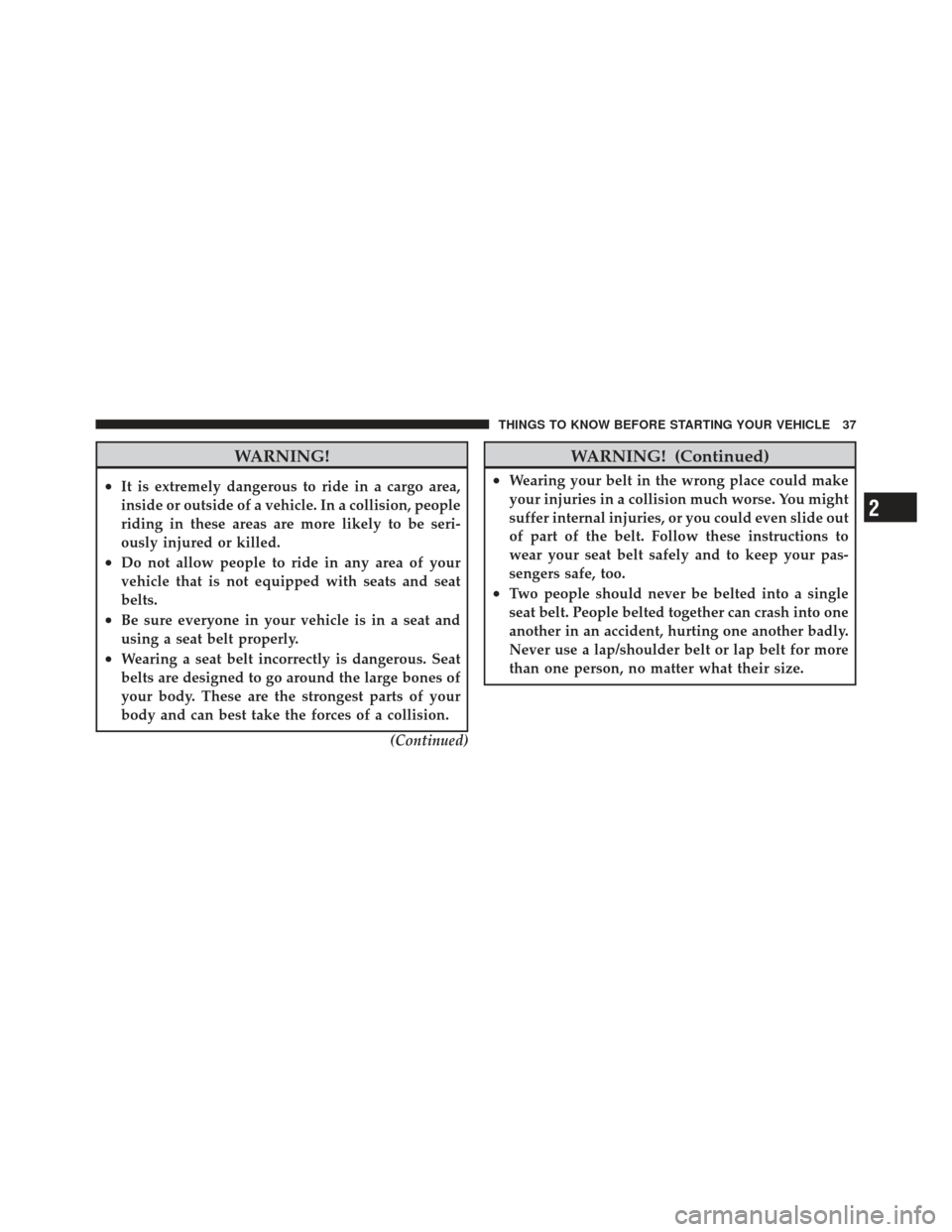Page 12 of 410

�Remote Keyless Entry (RKE) .............. 20
▫ To Unlock The Doors And Liftgate ......... 21
▫ To Lock The Doors And Liftgate .......... 22
▫ To Turn Off “Flash Lights With Lock” ....... 22
▫ Panic Alarm ......................... 23
▫ To Program Additional Transmitters ........ 23
▫ General Information ................... 25
▫ Transmitter Battery Service .............. 26
� Door Locks ........................... 27
▫ Manual Door Locks ................... 27
▫ Power Door Locks .................... 28
▫ Child Protection Door Lock System —
If Equipped ......................... 30 �
Power Windows ....................... 31
▫ Auto-Down Feature ................... 32
▫ Rear Window Switches ................. 33
▫ Wind Buffeting ....................... 33
� Liftgate ............................. 33
� Occupant Restraints ..................... 35
▫ Lap/Shoulder Belts .................... 36
▫ Lap/Shoulder Seat Belt Untwisting
Procedure ........................... 42
▫ Adjustable Upper Shoulder Seat Belt
Anchorage .......................... 43
▫ Seat Belt Pretensioners ................. 43
▫ Enhanced Seat Belt Use Reminder System
(BeltAlert�) ......................... 44
10 THINGS TO KNOW BEFORE STARTING YOUR VEHICLE
Page 13 of 410
▫Seat Belts And Pregnant Women .......... 45
▫ Driver And Front Passenger Supplemental
Restraint System (SRS) - Airbag ........... 45
▫ Child Restraints ...................... 62
▫ Transporting Pets ..................... 70
� Engine Break-In Recommendations .......... 70�
Safety Tips ........................... 71
▫ Transporting Passengers ................ 71
▫ Exhaust Gas ......................... 71
▫ Safety Checks You Should Make Inside The
Vehicle ............................. 72
▫ Periodic Safety Checks You Should Make
Outside The Vehicle ................... 73
2
THINGS TO KNOW BEFORE STARTING YOUR VEHICLE 11
Page 26 of 410

total of eight RKE transmitters can be programmed to
your vehicle through the use of a currently-programmed
RKE transmitter.
NOTE:If vehicle is equipped with the optional EVIC in
the instrument cluster, the RKE transmitters may also be
programmed through the EVIC display.
Use the following procedure to program additional RKE
transmitters if the vehicle is not equipped with Sentry
Key�:
NOTE: When entering program mode using currently-
programmed RKE transmitter, all other programmed
transmitters will be erased and you will have to repro-
gram them for your vehicle.
1. Gather every transmitter that is to be used with the
vehicle, including any transmitters that are currently
programmed.
2. Enter your vehicle and close all doors. 3. Fasten your seatbelt. (Fastening the seatbelt will cancel
any chimes that may confuse you during this program-
ming procedure.)
4. Place the key into the ignition.
5. Turn the ignition to the ON position.
Do not start the
engine.
6. Press and hold the UNLOCK button on the RKE
transmitter.
7. After holding the UNLOCK button for four seconds,
also press the PANIC button within six seconds.
8. When a single chime is heard, release both buttons.
The chime is an indication that you have successfully
entered program mode. All RKE transmitters that are to
be programmed must be done so within 60 seconds of
when the chime was heard.
24 THINGS TO KNOW BEFORE STARTING YOUR VEHICLE
Page 37 of 410

OCCUPANT RESTRAINTS
Some of the most important safety features in your
vehicle are the restraint systems. These include:
•Front and rear seat belts for all passengers
•Front airbags for both the driver and front passenger
•Pretensioning and load-limiting retractors for the front
seat belts
•Knee Impact Blocker panels for front seat occupants
•Supplemental Side Airbag Inflatable Curtains (SABIC)
that span the front and second rows for sedans (if
equipped)
•Front seat belt retractors that incorporate pretension-
ers to enhance occupant protection by managing oc-
cupant energy during an impact eventIf you will be carrying children too small for adult-sized
seat belts, the seat belts or the Lower Anchors and Tether
for CHildren (LATCH) feature can also be used to hold
infant and child restraint systems.
Refer to the Lower Anchors and Tether for CHildren
(LATCH) system explanation in this section.
Please pay close attention to the information in this
section. It tells you how to use your restraint system
properly, to keep you and your passengers as safe as
possible.
2
THINGS TO KNOW BEFORE STARTING YOUR VEHICLE 35
Page 38 of 410

WARNING!
In a collision, you and your passengers can suffer
much greater injuries if you are not properly buckled
up. You can strike the interior of your vehicle or other
passengers, or you can be thrown out of the vehicle.
Always be sure you and others in your vehicle are
buckled up properly.
Buckle up even though you are an excellent driver, even
on short trips. Someone on the road may be a poor driver
and cause a collision that includes you. This can happen
far away from home or on your own street. Research has shown that seat belts save lives, and they
can reduce the seriousness of injuries in a collision. Some
of the worst injuries happen when people are thrown
from the vehicle. Seat belts reduce the possibility of
ejection and the risk of injury caused by striking the
inside of the vehicle.
Everyone in a motor vehicle should
be belted at all times.
Lap/Shoulder Belts
All the seats in your vehicle are equipped with lap/
shoulder belts.
The belt webbing retractor is designed to lock during
very sudden stops or collisions. This feature allows the
shoulder part of the belt to move freely with you under
normal conditions. But in a collision, the belt will lock
and reduce the risk of you striking the inside of the
vehicle or being thrown out.
36 THINGS TO KNOW BEFORE STARTING YOUR VEHICLE
Page 39 of 410

WARNING!
•It is extremely dangerous to ride in a cargo area,
inside or outside of a vehicle. In a collision, people
riding in these areas are more likely to be seri-
ously injured or killed.
•Do not allow people to ride in any area of your
vehicle that is not equipped with seats and seat
belts.
•Be sure everyone in your vehicle is in a seat and
using a seat belt properly.
•Wearing a seat belt incorrectly is dangerous. Seat
belts are designed to go around the large bones of
your body. These are the strongest parts of your
body and can best take the forces of a collision.(Continued)
WARNING! (Continued)
•Wearing your belt in the wrong place could make
your injuries in a collision much worse. You might
suffer internal injuries, or you could even slide out
of part of the belt. Follow these instructions to
wear your seat belt safely and to keep your pas-
sengers safe, too.
•Two people should never be belted into a single
seat belt. People belted together can crash into one
another in an accident, hurting one another badly.
Never use a lap/shoulder belt or lap belt for more
than one person, no matter what their size.
2
THINGS TO KNOW BEFORE STARTING YOUR VEHICLE 37
Page 40 of 410
Lap/Shoulder Belt Operating Instructions
1. Enter the vehicle and close the door. Sit back and
adjust the seat.
2. The seat belt latch plate is above the back of the front
seat, next to your arm. Grasp the latch plate and pull out
the belt. Slide the latch plate up the webbing as far as
necessary to allow the belt to go around your lap.
WARNING!
A shoulder belt placed behind you will not protect
you from injury during a collision. You are more
likely to hit your head in a collision if you do not
wear your shoulder belt. The lap and shoulder belt
are meant to be used together.3. When the belt is long enough to fit, insert the latch
plate into the buckle until you hear a “click.”
Latch Plate
38 THINGS TO KNOW BEFORE STARTING YOUR VEHICLE
Page 41 of 410
WARNING!
•A belt that is worn under your arm is very danger-
ous. Your body could strike the inside surfaces of the
vehicle in a collision, increasing head and neck
injury. A belt worn under the arm can cause internal
injuries. Ribs aren’t as strong as shoulder bones.
Wear the belt over your shoulder so that your stron-
gest bones will take the force in a collision.
• A shoulder belt placed behind you will not protect
you from injury during a collision. You are more
likely to hit your head in a collision if you do not
wear your shoulder belt. The lap and shoulder belt
are meant to be used together.
Inserting Latch Plate Into Buckle
2
THINGS TO KNOW BEFORE STARTING YOUR VEHICLE 39